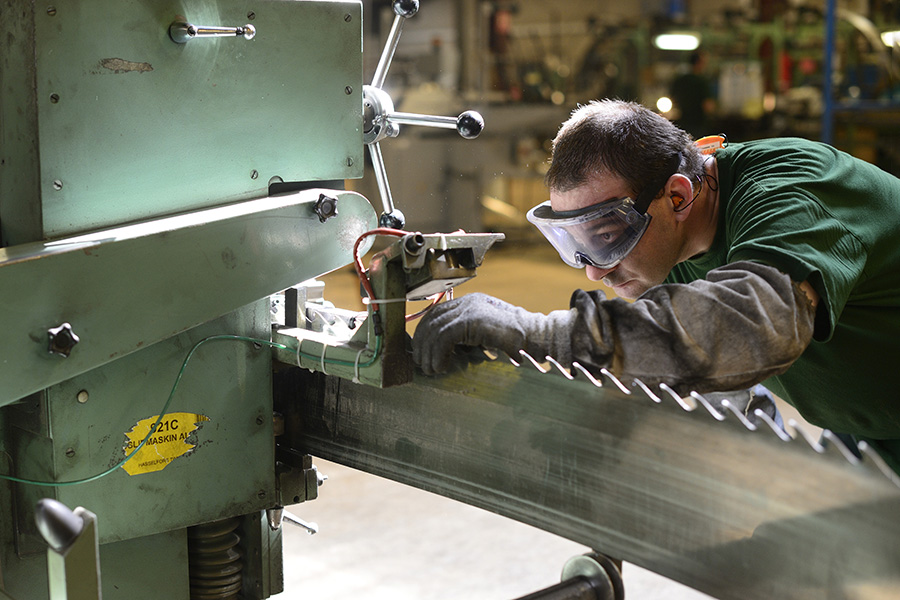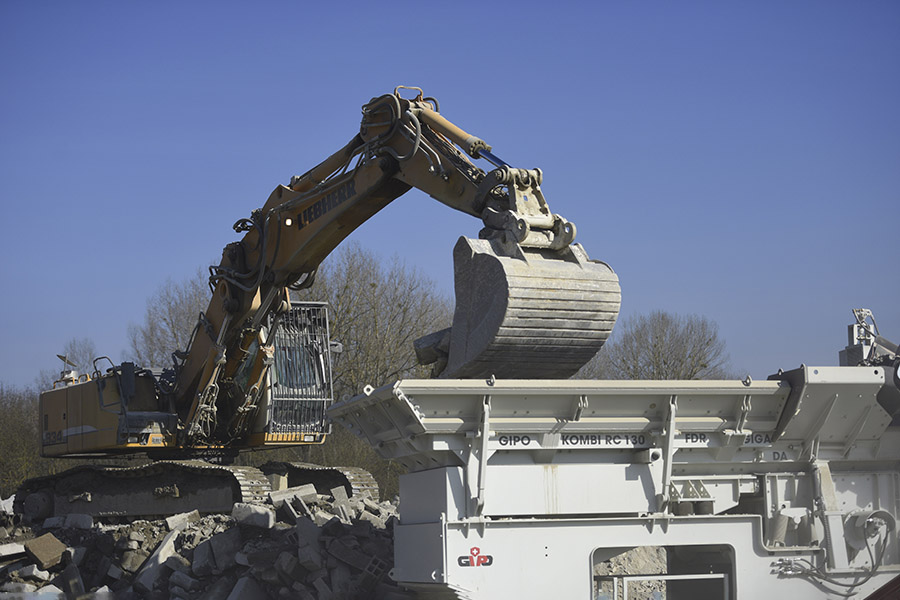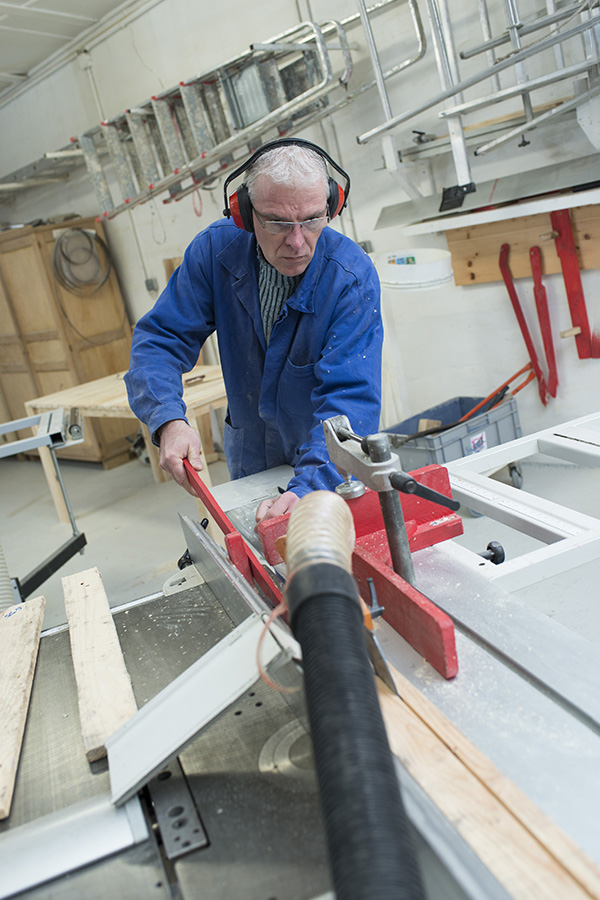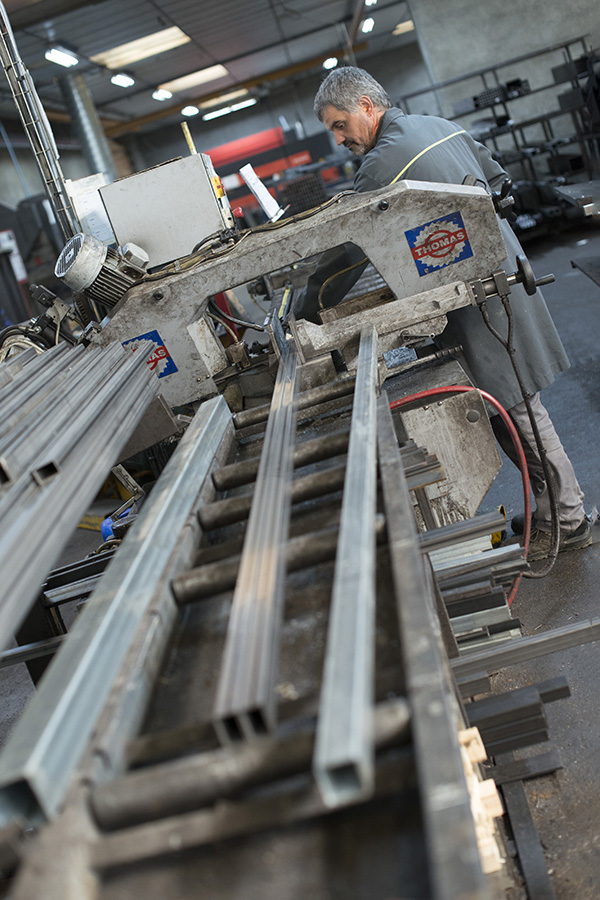Work Equipment Engineering division
The activities of the Work Equipment Engineering division are aimed at the prevention of the occupational diseases due to physical nuisances (noise, vibrations, and radiation) as well as at the prevention of accidents due to machines, automated systems and tools.
Workplace acoustics
The acoustics laboratory has recognised expertise in all areas of workplace acoustics.
The main topics related to noise exposure are the reduction of machine or process noise, at source or by means of enclosures, the improvement of acoustics in workshops or open-plan offices and the evaluation of the effectiveness of personal noise protectors.
Over the last decade, the laboratory has become a major player in the field of noise perception in open-plan offices.
In close collaboration with specialists in ergonomics and psychology at work, it develops new analysis methods for problems such as intelligibility and fatigue in open-plan offices or the comfort of individual protectors.
It also conducts research on speech intelligibility and audibility of alarms for employees with hearing loss with a view to their continued employment.
Publications
- Arz J-P, Gettliffe J-P, Delattre P. Effect of wearing hearing protectors on the audibility of railway warning signals–an experimental study. International journal of occupational safety and ergonomics. 2018; 24(1):149-59.
- Brocolini L, Parizet E, Chevret P. Effect of masking noise on cognitive performance and annoyance in open plan offices. Applied Acoustics. 2016; 114:44-55.
- Lenne L, Chevret P. Long-term effects of the use of a sound masking system in open-plan offices : a field study. Applied Acoustics. 2020; 158:1-10
- Chevret P, Chatillon J. Implementation of diffraction in a ray-tracing model for the prediction of noise in open-plan offices. The Journal of the Acoustical Society of America. 2012; 132(5):3125-37.
- Terroir J, Doutres O, Sgard F. Towards a" global" definition of the comfort of earplugs. 2017; INTER-NOISE and NOISE-CON Congress and Conference Proceedings, InterNoise17, Hong Kong CHINA, pages 1-1003, pp. 108-114(7).
- Trompette N, Chatillon J, Survey of Noise Exposure and Background Noise in Call Centers Using Headphones, Journal of Occupational and Environmental Hygiene. 2012, 9:6, 381-386.
Electromagnetism - Vibration – Optics
This laboratory aims to improve the prevention of the risks inherent in occupational exposure to the three physical nuisances: electromagnetic fields, vibrations and optical radiation. It is also interested in the risk of accidents (overturning of forklift trucks, securing of loads) with skills in mechanics and numerical calculations.
Studies and research are aimed in particular at:
- The improvement of knowledge on sources of physical nuisance (industrial machines radiating electromagnetic fields, optical radiation sources, vibrating machines, vehicles or logistics trucks), their modes of transmission and their effects on health.
- Evaluating the performance of collective and individual means of protection and developing prevention engineering.
- The development of simplified risk assessment tools for a broad public not specialised in these physical nuisances.
To do this, the laboratory develops and improves measurement techniques, masters the means of digital modelling (simulation) and implements test benches to compare and confirm theory and experience, models and measurements.

© Guillaume J. Plisson pour l'INRS

© Guillaume J. Plisson pour l'INRS
Publications
- Amari M., Caruel E., Donati P. Inter-individual postural variability in seated drivers exposed to whole-body vibration. Ergonomics, Volume 58, n° 7, 1162-1174, 2015.
- Barlier-Salsi A. Stray light correction on array spectroradiometers for optical radiation risk assessment in the workplace. J Radiol Prot 34:915-30, 2014, https://iopscience.iop.org/article/10.1088/0952-4746/34/4/915
- Brissinger D. Complex refractive index of polycarbonate over the UV-Vis-IR region from 0.2 to 3 μm, Appl. Opt. 58, 1341-1350, 2019.
- Deniel J. M., Optimizing array spectroradiometer readings using adaptative bracketing. Review of Scientific instruments 87, 033108, 2016.
- Donati P. Joël’s Breaker: Forty Years of European Vibration Prevention. Industrial Health. 2012. 50(5):370-6
- Fleury G. Numerical modelling of vibration emitted by pneumatic chipping hammers, 14th International Conference on Hand Arm Vibration, Bonn, 2019, https://dguv.de/medien/ifa/de/vera/2019_hav/hav_2019_abstracts.pdf
- Hammen L. Assessment of occupational exposure during arc welding, BioEM2019, Montpellier, France, June 23 - 28, 2019.
- Noel C. Measuring dynamic stiffnesses of preloaded distal phalanges in vibration - Test Bench validation and parameter study. International Journal of Industrial Ergonomics 59, 64-79, 2017.
- Rebelle J. A New Test Code to Assess Irregularity Effects of Dock Equipment used for loading/unloading operations, DOI: 10.13140/RG.2.2.22004.91521
Safe Design—Protection and Human-Machine Interfaces
This laboratory constitutes one of the poles of competence in the field of machine safety, which is fully engaged on the subject of the industry of the future.
Safe Design Engineering
Studies in this field combine engineering and human sciences. They aim to develop knowledge, methods and tools to help machines, workshops or facilities designers to integrate the real use of equipment in their projects and risks evaluation throughout the design process. Most of these studies are carried out in partnership with academic research laboratories.
Man machine interfaces
The studies carried out in this field concern mainly innovative collective or individual protection equipment (wearable smart system, head worn or machine display, lone worker devices, detection by vision or data fusion, safety nets, manual handling trolley, etc.). Their objectives are to evaluate the advantages and the limitations of these systems and to develop standardized test methods

© Grégoire Maisonneuve pour l'INRS
Publications
- Daille-Lefevre B, Fadier E, Marsot J, Dequaire E, Roignot R. Risk prevention during machine design (Integration of user behaviour in the specifications drawn up). Bibliothèque virtuelle de l'AFNOR (la BiVi), MAR-A-III-20-20, novembre 2015, 13 p.
- Feno M.R, Martin P, Daille-Lefevre B, Etienne A, Marsot J, Siadat A. Safety of machinery: requirement specification based on functional need and work situations analysis. International Journal on Interactive Design and Manufacturing (IJIDeM), ISSN 1955-2513, DOI 10.1007/s12008-017-0447-3, 19 December 2017, 13p
- Gille S, Kerangueven L. Incorporating occupational risk prevention into the design of equipment for assisting in moving and handling people. Hygiène et sécurité du travail, September 2017, n° 248, nt52, pp. 50-56.
- Grand G. Safety net ageing: level of confidence in the degradation evaluation. International Journal of Occupational Safety and Ergonomics, august 2020, DOI: 10.1080/10803548.2020.1786959, 14 p.
- Lux A, Mawo De Bikond J, Etienne A, Quillerou E. Approach to analyse hazardous situations tied to recurrent production dysfunctions, by observing the work situation. International Journal of Occupational Safety and Ergonomics, July 2020, DOI: 10.1080/10803548.2020.1765113, 10 p.
- Marchal P. General principles of smart personal protection systems design. Proceedings of the 9th International Conference on Safety of Industrial Automated Systems SIAS 2018, Nancy, France, October 10-12, 2018, pp. 122-128.
- Marsot J. The industry of the future: what are we talking about ? Hygiène et sécurité du travail, décembre 2018, n° 253, dc23, pp. 6-10.
- Perrin P, Lux A, Wild P, Marsot J. Preventing plant-pedestrian collisions: Camera & screen systems and visibility from the driving position. International Journal of Industrial Ergonomics, 2016, Vol. 53, pp. 284-290.
- Savin J, Gaudez C, Gilles M, Padois V, Bidaut P. Digital Human Model Simulation of Fatigue-induced Movement Variability during a Repetitive Pointing Task. Proceedings of the XXth Symposium of IEA (International Ergonomics Association), IEA 2018, Florence, Italy, August 26-30, 2018, pp. 96-105.
- Tihay D, Perrin N. Human-robot coactivity: need’s analysis. Proceedings of the 9th International Conference on Safety of Industrial Automated Systems SIAS 2018, Nancy, France, October 10-12, 2018, pp. 40-47.
Safety of work equipment and automated systems
This laboratory constitutes the other pole of competence in the field of machine safety, which is fully engaged, on the subject of the industry of the future.
The activities of this laboratory fall within the general field of safety of work equipment and the operating safety of automation systems. They aim to analyze the risks generated by automated systems and to control their consequences on worker safety.
The studies and research carried out in the laboratory are widely intended to take into account the increasing complexity of systems and their automatisms. They relate to:
- The safe design of automated installations (e.g. integrating machines, robots, protection or driver assistance devices, etc.),
- Methods of designing automation systems in relation to safety,
- Analysis of the prevention problems posed by a machine throughout its life cycle (installation, production, maintenance, dismantling, etc.).
The laboratory is interested in the prevention of professional risks linked to the emergence of new technologies: robotics, flexible and collaborative robotics, mobile machines, digitisation of production or surveillance data, artificial intelligence, cybersecurity...

© Grégoire Maisonneuve pour l'INRS
Publications
- Baudoin J, Bello J.P. Approaching standard EN ISO 13849-1 by designing a basic safety function, January 2014, NS 315, 56 p.
- Baudoin J, Bello J.P. Servomotor press design - Safety recommendations. Note Scientifique et Technique de l’INRS, NS 340, January 2016, 74 p.
- Blaise J.C, Levrat E, Iung B. Process approach-based methodology for safe maintenance operation: from concepts to SPRIMI software prototype, - Safety Science, 2014, Vol. 70, pp. 99-113.
- Blaise J.C. Integrating maintenance into design: the machinery directive sets goals. Magazine of the European agency for safety and health at work, Vol. 12 - Healthy Workplaces - A European Campaign on Safe Maintenance - ISSN 1608-4144 - pp. 39-41.
- Duponnois R, Lamy P, Levrat E, Siadat A. Working situation’s reference model for Risk assessment on automated assembly lines. Proceedings of the 30th European Safety and Reliability Conference and the 15th Probabilistic Safety Assessment and Management Conference, Venice, Italy, 1 au 6 novembre 2020, 8 p.
- Giraud, L, Blaise J.C, Tissot C. Analysis of machinery accidents in the food processing industry during the cleaning and disinfection phases. Proceedings of the 9th International Conference on Safety of Industrial Automated Systems SIAS 2018, Nancy, France, October 10-12, 2018, pp. 277-282.
- Lamy P, Perrin N. Approach to analyse hazardous situations tied to recurrent production dysfunctions, by observing the work situation. International Journal of Occupational Safety and Ergonomics, july 2020, DOI: 10.1080/10803548.2020.1765113, 10 p.
- Lamy P. Machine Safety: the "cyber risk" as an emerging risk? Hygiène et sécurité du travail, n° 256, september 2019, NT76, pp. 72-79
- Sghaier A, Baudoin J, Bello J.P, Jocelyn S, Burlet-Vienney D, Giraud L. Industrial collaborative robot application: experimental implementation of safety-rated monitored stop. Proceedings of the 9th International Conference on Safety of Industrial Automated Systems SIAS 2018, Nancy, France, October 10-12, 2018, pp. 62-68.


